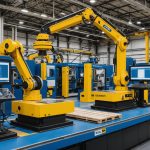Current Trends in Food Delivery Logistics
The UK food industry is witnessing a dynamic transformation driven by evolving consumer behaviors and advances in logistics optimization. As consumer demand for speedy and convenient food delivery increases, companies are compelled to innovate.
Emerging trends in food delivery logistics include the use of advanced algorithms for route optimization. This fine-tunes delivery routes to save time and reduce costs, elevating both efficiency and customer satisfaction. Additionally, contactless delivery has gained momentum in response to safety concerns, reshaping delivery services to meet modern consumer expectations.
Also to discover : Building a powerful brand reputation strategy for uk startups in the digital age
Technological advancements play a crucial role in this shift. The integration of artificial intelligence (AI) and machine learning applications are improving logistics operations. With real-time data analytics, businesses can predict delivery times more accurately, ensuring timely fulfillment of orders.
Mobile apps and digital platforms have also become invaluable tools, enabling users to place orders seamlessly. They allow customers to track orders in real-time, enhancing transparency and trust. As logistics optimization continues to evolve, food delivery providers are better equipped to adapt to these shifts, ultimately refining their services to match the changing landscape of consumer preferences. These trends indicate a promising future for the UK’s food delivery industry.
Also to discover : Exploring the Legal Landscape of Biometric Data Use in UK Workplaces: Implications and Insights
Successful Case Studies in Food Delivery
Exploring successful case studies in food delivery provides insight into the strategies utilised by industry leaders to excel in logistics. A prominent example is how UberEats optimised their delivery times using data-driven approaches. By analysing traffic patterns and ordering peaks, they enhanced the efficiency of their delivery routes.
Key strategies these companies employ include leveraging technology for seamless operations. DoorDash, for instance, uses machine learning algorithms to predict customer demand and optimise driver routes, resulting in reduced delivery times and increased customer satisfaction. These food delivery examples highlight the importance of technological integration in modern logistics.
Another exemplary case is how Deliveroo implemented a structured approach to successful logistics by creating strategically located ‘Deliveroo Editions’ kitchens. This reduces the time taken to prepare and deliver food, especially in high-demand zones. It showcases the significance of infrastructure in logistics efficiency.
Lessons from these case studies emphasize focusing on customer convenience and operational efficiency. Efficient logistic strategies are critical for businesses striving to thrive in competitive markets. The integration of cutting-edge technology and strategic planning remains pivotal in rewriting the rules of food delivery success.
Technology Integration for Streamlined Operations
In the rapidly evolving food delivery sector, technology integration stands as a crucial component for driving efficiency and enhancing customer satisfaction. At the forefront are sophisticated delivery management systems, which coordinate complex logistics tasks seamlessly. These systems enable businesses to automate many processes, significantly reducing human error and labour costs.
Automation in logistics provides accurate real-time tracking, offering transparency that boosts customer trust. This real-time data allows customers to monitor their delivery process, making informed decisions and adjustments as needed. With predictive analytics, companies can anticipate bottlenecks and optimise routes, ensuring timely deliveries even during peak hours.
Looking ahead, the future of technology in the food delivery industry is promising. Innovations like drones and autonomous vehicles are gradually being tested, representing potential game-changers for reducing delivery times. Smart kitchens, integrated with IoT devices, streamline meal preparation processes, boosting efficiency from order receipt to dispatch.
Moreover, artificial intelligence is set to revolutionise customer service, providing personalised recommendations and managing inquiries with minimal human intervention. These developments highlight the continued emphasis on adapting cutting-edge technology to enhance operational capabilities and meet growing consumer demands efficiently.
Supply Chain Management Solutions
Effective supply chain management is crucial for businesses, particularly within food supply logistics. By integrating streamlined strategies, companies can enhance their service delivery and maintain a competitive edge. Efficient supply chains rely heavily on the precise coordination of resources, time, and information.
A primary goal in food supply logistics is achieving efficiency in supply chains. This involves implementing advanced forecasting methods to anticipate demand accurately and minimize wastage. An optimised inventory management system not only cuts costs but also ensures freshness, especially vital in perishable goods supply.
Collaboration forms the backbone of efficient logistics; hence, establishing strong ties with suppliers is indispensable. Building such relationships can facilitate foresight into potential demand fluctuations, enabling companies to scale operations accordingly. Moreover, it provides a platform for negotiated terms that can lead to shared benefits and flexibility in operations.
Companies often deploy technology-driven approaches to optimise their distribution networks. These methods may include real-time tracking systems and data analytics tools for continuous improvement in performance. By harnessing these technologies, businesses can improve accuracy and speed within the food delivery services, ultimately enhancing customer satisfaction and loyalty. In this manner, a well-managed supply chain serves as a foundation for sustained success in competitive markets.
Customer Satisfaction Metrics
Customer satisfaction in the food delivery sector is crucial for business growth. Understanding and improving this requires evaluating specific Key Performance Indicators (KPIs). These KPIs can include things like order accuracy, delivery time, and customer service quality. Measuring these effectively allows businesses to ensure they meet customer expectations.
Gathering and analyzing customer feedback is another vital aspect. Feedback can be collected through surveys, apps, and social media, offering insights into the food delivery experiences of customers. This data is instrumental in identifying trends and improving service. For example, if customers consistently report late deliveries, an investigation into delivery metrics can pinpoint bottlenecks.
High customer satisfaction directly impacts business growth in the delivery sector. Happy customers are more likely to become repeat clients and may recommend the service to others, increasing the customer base. On the other hand, poor customer satisfaction can harm reputation and hinder growth. Thus, focusing on these metrics isn’t just about pleasing customers—it’s a business imperative.
Innovative businesses often employ strategies such as incorporating customer feedback into product development, offering targeted promotions, or improving delivery processes to enhance customer satisfaction. By prioritizing these factors, companies can maintain a competitive edge in the bustling food delivery market.
Best Practices in Food Delivery Logistics
In the realm of food delivery services, maintaining top-notch efficiency and quality is pivotal. Understanding and implementing best practices can be the game-changer in logistics management. Streamlining operations begins with precise coordination. This includes scheduling, tracking, and optimising delivery routes to ensure timely deliveries.
A cornerstone of successful logistics is comprehensive staff training. Investing in employees’ skills fosters a resilient and knowledgeable workforce. Regular workshops on customer service and problem-solving equip staff to handle the dynamism of food delivery services efficiently. Well-managed teams not only enhance the customer experience but also drive operational success.
Another critical factor is balancing cost efficiency with service quality. This balance can be achieved by technology integration, like employing sophisticated route optimisation tools. These solutions reduce fuel costs and travel time, contributing significantly to financial efficiency without compromising delivery speed or food quality.
Prioritising best practices in logistics management ensures that food delivery services are not only efficient but also consistently meeting customer expectations. By fostering skilled staff and leveraging technology, businesses can offer seamless service while optimizing costs, maintaining a competitive edge in the bustling food delivery landscape.











